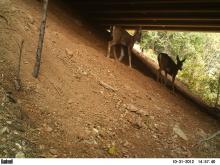~~This project will result in the creation of web-connected, wired and wireless camera systems for wildlife detection associated with ad hoc (e.g., street under-crossings and culverts) and purpose-built wildlife crossing structures. In order to integrate the physical camera system into transportation decision-making, monitoring, and stewardship activities, the project will be conducted in full partnership with Caltrans biologists and transportation camera system technical staff. The wired and wireless camera systems will represent an advance over traditional remote cameras in that their output will be viewable almost instantly on the web via a wireless data transportation service, as opposed to weeks or months later and viewable only to a limited selection of staff. Although streaming wildlife cameras are not a new thing, “wildlife traffic cameras” have not been used before in this way. We will develop a model system that any DOT can use in areas with wired, wireless, or cell system connectivity, including using existing “traffic cam” infrastructure to add wildlife monitoring to the data stream. This represents substantial portions of the US highway system, including rural areas with interstate traffic. We will investigate the use of image analysis software to automate the identification of common wildlife species captured in pictures from remote cameras. Systematic collection of wildlife movement information at the right-of-way not only benefits long-term and project related stewardship and mitigation requirements, it also provides an opportunity to share wildlife data and imagery directly with the public. This combination of science and public relations is increasingly important as public knowledge and awareness can contribute towards safer wildlife interactions with highways and traffic.
(This project is funded by the Federal Highways Administration)

